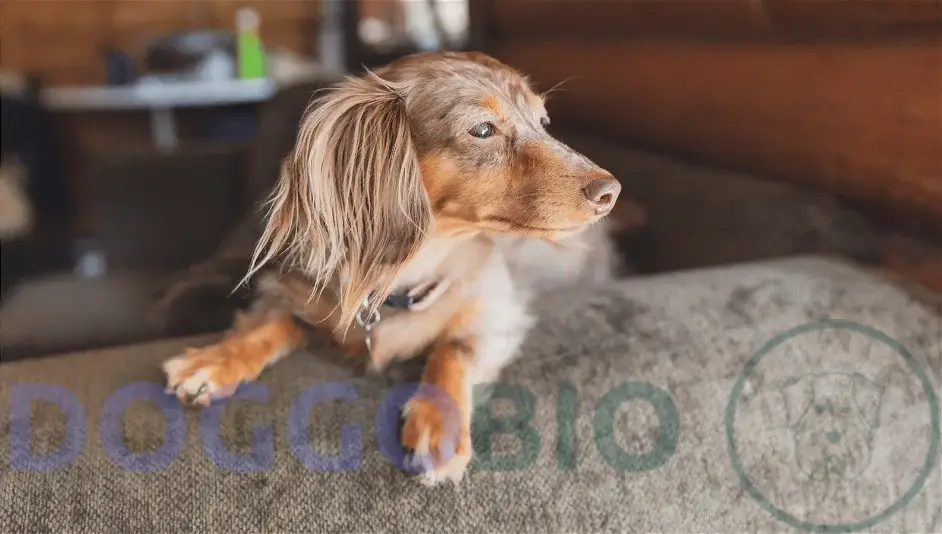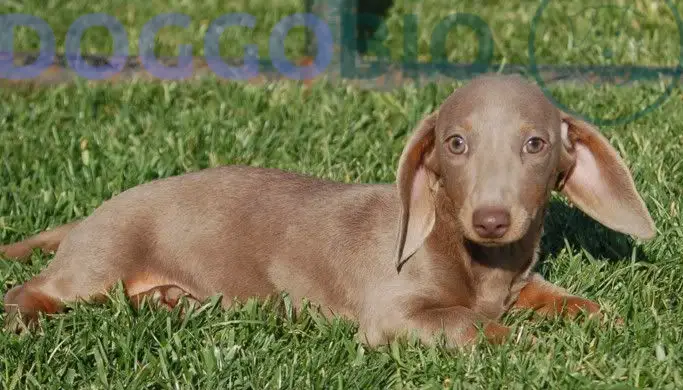The Isabella Dachshund stands as a rare gem in the canine world, distinguished by its unique coat color and endearing personality. This introduction offers a brief insight into this dog breed, known for its distinctive ‘Isabella’ shade – a dilute fawn color that ranges from silvery beige to lavender-gray. A result of a specific genetic combination, this coloration makes the Isabella Dachshund not only visually striking but also a subject of interest in canine genetics.
Join us as we delve into the origins, characteristics, and cherished bond between Isabella Dachshunds and their fortunate companions. Whether you’re a seasoned admirer or a newcomer to the breed, prepare to embark on a journey that celebrates the remarkable legacy of Isabella Dachshunds.
A Brief Overview of Isabella Dachshund
| Feature | Description |
| Coat | Short, smooth, or longhaired |
| Color | Chocolate brown with a silvery-blue sheen (faded black) |
| Markings | May have tan points on eyebrows, paws, and chest |
| Size | Miniature (under 11 lbs) or Standard (16-32 lbs) |
| Temperament | Loyal, playful, intelligent, stubborn, can be vocal |
| Energy Level | Moderate |
| Lifespan | 12-16 years |
| Health Concerns | Prone to intervertebral disc disease (IVDD), patellar luxation, and obesity |
What is a Isabella Dachshund?

An Isabella Dachshund is a light brown or fawn-colored Dachshund that carries a recessive gene from both parents, which diminishes the chocolate color of their fur. Their body may be of one color, with some exhibiting patterns of cream or tan mixed in. The term “Isabella Dachshund” is synonymous with “fawn Dachshund.”
History of Isabella Dachshund
With their unique body shape and keen sense of smell, these dogs were initially bred in Germany for hunting purposes. Their primary prey included badgers and rabbits; their name “Dachshund” translates to “badger dog” in German.
Over time, as breeding practices evolved and diversified, various coat colors and patterns emerged, including the rare Isabella color.
Today, while they are no longer used for hunting, their instinctual behaviors and unique appearance make them beloved pets worldwide. The Isabella color has become a symbol of rarity and beauty in the Dachshund community.
What does an Isabella Dachshund look like?

Size, height, and Weight
The Isabella Dachshund, like its other Dachshund counterparts, is a small to medium-sized dog with a distinct silhouette. Their elongated bodies and short legs are iconic features of the breed.
- Typically, standard Isabella Dachshunds stand between 8 to 9 inches tall and weigh between 16 to 32 pounds.
- The miniature variants are more minor, standing between 5 to 6 inches and weighing around 11 pounds on average.
Their size makes them suitable for various living situations, from apartments to houses with yards. It’s also worth noting that their unique body shape while endearing, requires special care and attention to prevent potential health issues.
Coat Colors and Types
The primary coat color of the Isabella Dachshund is a light brown or fawn hue. However, this color can vary in intensity, and some dogs may exhibit patterns like dapple or piebald, adding to their unique appearance.
Additionally, their coats can be of three types: smooth, long-haired, or wire-haired. Each coat type has its own grooming requirements and aesthetic appeal.
The smooth coat is sleek and shiny, the long-haired variant boasts elegant locks, and the wire-haired type offers a rugged, curly look. Observing the subtle differences in shades and tones between individual dogs is fascinating, making each Isabella Dachshund unique.
Temperament and Personality
Isabella Dachshunds are a bundle of joy, energy, and intelligence. They are known for their playful nature, unwavering loyalty, and, sometimes, their stubbornness.
They form strong bonds with their families and are protective of their loved ones. Their hunting background means they are alert and can be wary of strangers, making them excellent watchdogs. However, proper socialization allows them to be friendly and get along well with other pets and children.
Their curious nature and intelligence mean they love engaging in mentally stimulating activities and games. It’s also worth noting that their independent streak, while endearing, requires consistent training and guidance to ensure they are well-behaved.
Training and Exercise Requirements
Isabella Dachshunds, despite their small size, are active and energetic. They require regular exercise to keep them fit and mentally stimulated. Daily walks, play sessions, and even agility training are great ways to keep them engaged.
Regarding training, their intelligent yet independent nature can pose a challenge. They can be stubborn sometimes, but they can be trained effectively with positive reinforcement, patience, and consistency. Early socialization and training are crucial to ensure they grow into well-rounded and well-behaved dogs. Understanding their hunting instincts and providing appropriate outlets to channel their energy and curiosity is also essential.
Grooming and Cleaning
Grooming requirements for Isabella Dachshunds vary based on coat type.
- Smooth-coated variants require minimal grooming, with occasional brushing to keep their coat shiny and healthy.
- Long-haired variants need regular brushing to prevent tangles and mats
- While wire-haired types require periodic stripping to maintain their coat’s texture.
Regular baths, nail trimming, and ear cleaning are also essential to keep them clean and healthy. Given their unique color, it is crucial to monitor their skin for any signs of issues or allergies.Regular vet check-ups and a balanced diet can further ensure their coat remains healthy and vibrant.
Food and Diet
A balanced diet is the cornerstone of any dog’s health, and the Isabella Dachshund is no exception. They thrive on high-quality commercial dog food or well-researched homemade meals.
Given their size, it’s essential to ensure they are fed the right amount to prevent obesity, which can lead to various health issues.
Fresh water should always be available, and treats should be given in moderation. Regular vet check-ups can guide their dietary needs and any supplements they might require.
Life Expectancy and Common Health Issues

1. Patellar Luxation
A common issue in many small dog breeds, patellar luxation involves the kneecap’s dislocation. It can cause discomfort and affect the dog’s mobility. Regular vet check-ups can help detect this issue early, and appropriate treatments or interventions can ensure the dog remains active and comfortable.
2. Intervertebral Disc Disease (VDD)
Given the Dachshund’s unique body shape, they are prone to spinal issues like VDD. This condition can be painful and affect their mobility.
Weight management, regular vet visits, and avoiding strenuous activities can help mitigate the risks associated with VDD.
3. Hip Dysplasia
This joint issue can lead to arthritis and discomfort in dogs. Regular exercise, weight management, and vet check-ups can help detect, manage, and prevent this condition.
4. Hyperadrenocorticism
Also known as Cushing’s Disease, it affects the adrenal gland’s cortisol production. Symptoms can include increased thirst, increased urination, and hair loss. Regular vet check-ups and appropriate treatments can help manage this condition.
5. Cataract
Cataracts can affect Isabella Dachshund’s vision, leading to cloudiness in the eye. Regular eye check-ups can help detect this condition early, and treatments or surgeries can ensure the dog’s comfort and vision.
6. Skin problems
Given their unique coloration, Isabella Dachshunds can be prone to skin issues like Color Dilution Alopecia (CDA). This condition can lead to hair thinning and potential bald spots.
How Much is an Isabella Dachshund?
An Isabella Dachshund can range from $400 to $3,500, depending on factors like breeder quality and location.
It’s essential to remember that the initial cost of purchasing the dog is just the beginning. Regular vet visits, grooming, food, and other essentials will add to the overall cost of owning this breed.
How Can I Find an Isabella Dachshund For Sale?
Finding an Isabella Dachshund for sale requires research and patience. Reputable breeders, breed clubs, dog shows, and online platforms are potential sources. However, ensuring that the breeder follows ethical practices, prioritizes the dogs’ well-being, and is knowledgeable about the breed is crucial.
Asking for references, reading reviews, and visiting the breeder’s facility can provide insights into their practices and the puppies’ health and temperament.
It’s also worth noting that given their rarity, patience is vital. Waiting for the perfect Isabella Dachshund might take time, but it is worth it.
Is this breed the Right Dog for You?
The Isabella Dachshund, with its captivating color and spirited personality, can be a joy. However, they come with their own set of needs and challenges. They require regular exercise, mental stimulation, and consistent training.
They can be a perfect fit for families, singles, or seniors who can give them the love, care, and attention they deserve.
Before getting one, assessing your lifestyle, living situation, and commitment level is essential to ensure a happy and harmonious relationship.
List of dogs that are similar to Isabella Dachshund
Frequently Asked Questions
Does AKC recognize Isabella Dachshund?
Yes, the American Kennel Club (AKC) recognizes the Isabella Dachshund. They are categorized under the two-colored Dachshunds and are a testament to the breed’s diversity and the various colors and patterns it can exhibit.
Is Isabella Dachshund Rare?
Indeed, the Isabella Dachshund is considered a rare variant of the breed. Their unique coloration and delightful personality make them highly sought after among dog enthusiasts and breeders.
What is the rarest color in Dachshund?
While several Dachshund colors are rare, the Isabella or fawn coloration is among the rarest. Their unique hue and potential patterns, like dapple or piebald, make them stand out and highly prized.
Are Isabella Dachshunds healthy?
Yes, like all breeds, Isabella Dachshunds can have potential health issues. However, with regular vet check-ups, a balanced diet, and proper care, they can lead a healthy and fulfilling life.
It’s also worth noting that their unique coloration can sometimes be associated with specific health issues, making regular vet visits and monitoring crucial.
Are Isabella Dachshunds prone to skin issues?
Yes, Given their unique color gene, they can be prone to skin issues like Color Dilution Alopecia (CDA).
Regular vet check-ups, proper grooming, and a balanced diet can help detect, manage, and prevent skin-related problems. It’s also worth noting that their skin requires special attention and care to ensure their comfort and well-being.
How Long Can an Isabella Dachshund Live?
With proper care, love, and attention, Isabella Dachshunds can live between 12 to 16 years. They can provide their families with years of love, joy, and companionship.
It’s also worth noting that their lifespan is a testament to their resilience and the care they receive from their families.
Do Isabella Dachshunds Shed A Lot?
Yes, Isabella Dachshunds can shed, but shedding can vary based on coat type.
Regular grooming can help manage shedding, ensure their coat remains healthy, and reduce the amount of hair around the home.
Are isabella Dachshunds hypoallergenic?
No, Isabella Dachshunds are not considered hypoallergenic. Those with allergies should consult with an allergist before getting one to ensure they can comfortably coexist.
It’s also worth noting that while they are not hypoallergenic, allergens can be managed with proper grooming and care.
Conclusion
The Isabella Dachshund is a marvel of nature, genetics, and selective breeding. Their unique color, combined with their spirited nature, makes them a standout in the dog world.
Whether you’re a seasoned Dachshund owner or considering getting one for the first time, the Isabella Dachshund promises a journey filled with love, joy, and discovery.
With proper care, attention, and understanding, they can be a delightful addition to any family, enriching lives with their presence. It’s also worth noting that their rarity, beauty, and charm make them a prized possession, promising years of companionship and joy.

Pingback: English Cream Dachshund: Graceful Majesty Unveiled 2024
Pingback: Dapple Dachshund: Discover Delightful Canine Patterns 2024